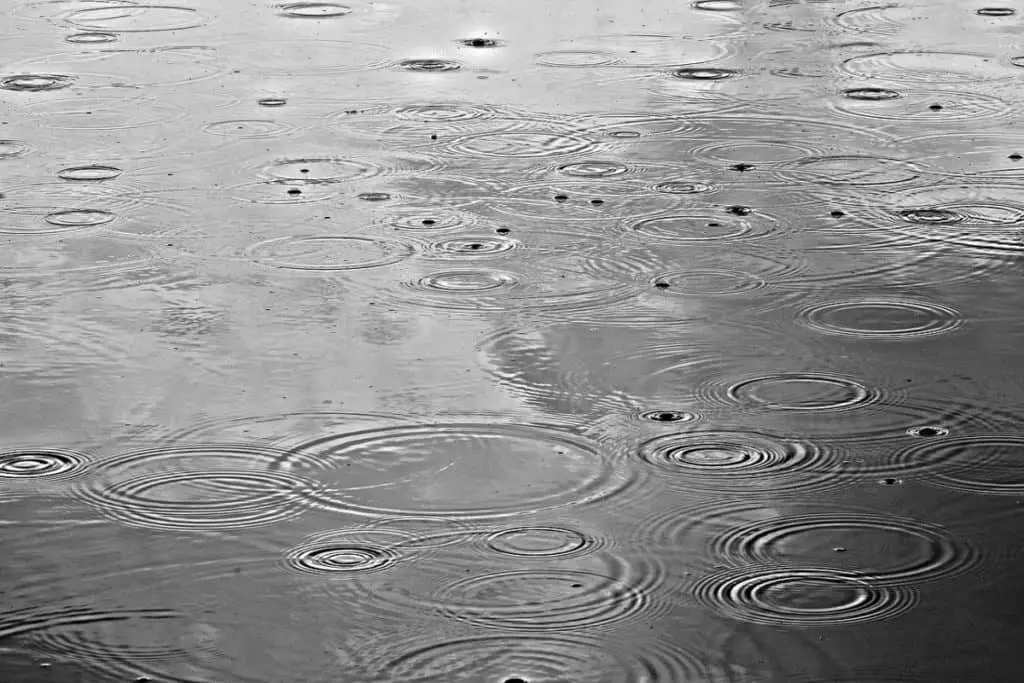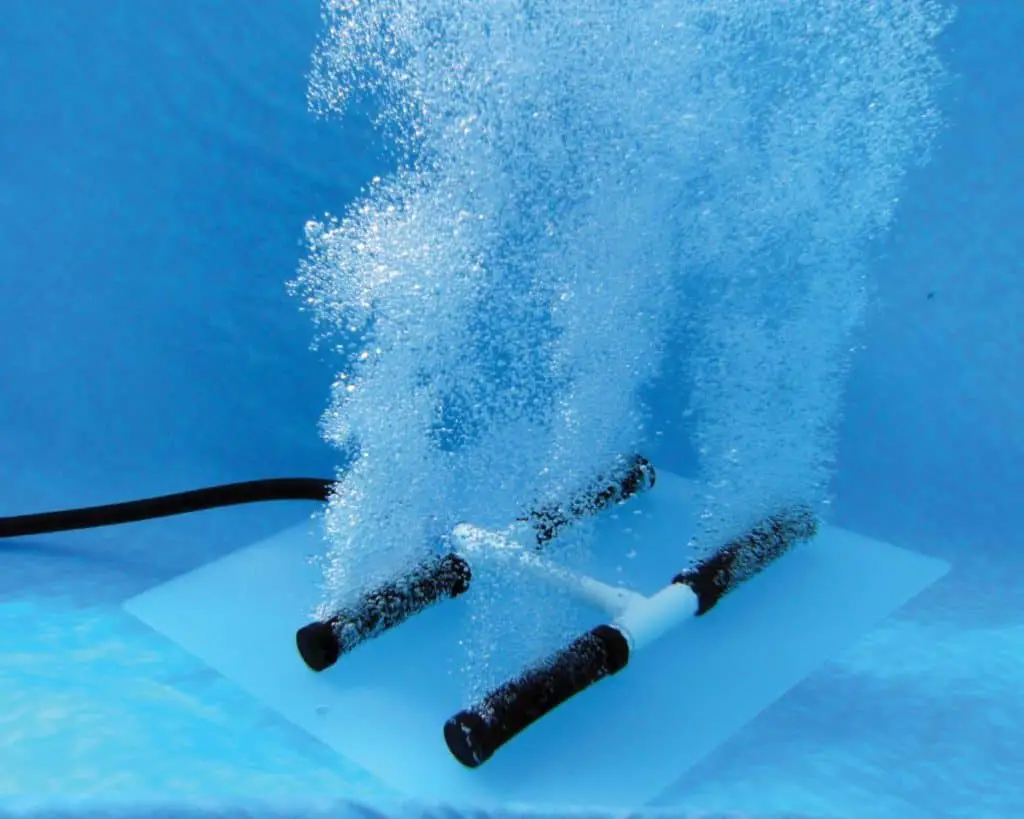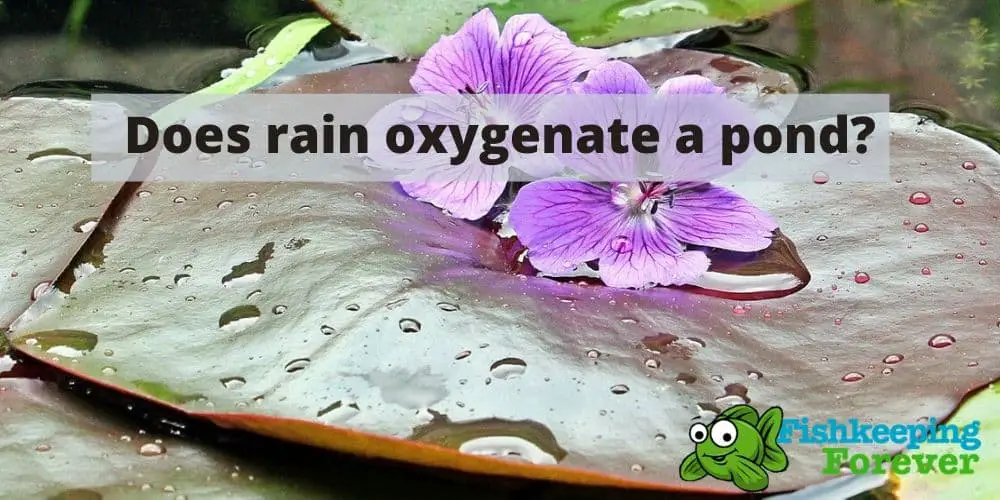Simply, yes; rain will contribute oxygen to a pond.
Rainwater is a helpful source of the dissolved oxygen your pond needs to thrive. It is also (usually) a clean and natural water source that can be confidently added to your pond water, due to the absence of harmful substances like chlorine.
In this article we will take a look at rainwater and whether or not it can be relied on for adequately oxygenating your pond, as well as your available options for ensuring that your pond water is adequately oxygenated.
Table of Contents
How does oxygen get into rainwater?
As rainwater falls, it comes into contact with the gases that make up our atmosphere:
- Nitrogen dioxide
- Carbon dioxide
- Oxygen
- Sulfur dioxide
Does the rain oxygenate a pond? These gasses can be absorbed and dissolved within the rainwater. Oxygen molecules (O2) form non-molecular (non-binding) associations with the water molecules in the rain and are carried to your pond where they become dissolved and ready for use by your pond life.
How much oxygen does a pond need?
A healthy pond is a thriving ecosystem that needs enough oxygen to adequately support the normal activities of fish, pond plants and other aquatic organisms.
Pond oxygen concentrations are typically in the range of 8-12 parts per million (around 0.001% or 10mg/l); similar levels to other types of freshwater. This is sufficient to support most pond-life, but if dissolved oxygen concentrations fall to below 3 parts per million, organisms will start to become stressed.

So, just how much oxygen is in rainwater?
The amount of oxygen carried in rainwater is 10 parts per million (0.001% or 10mg/l), a tiny proportion considering oxygen makes up 21% of the earth’s atmosphere, but comparable to the concentration in pond water.
Raindrops splashing into your pond also create vital water movement, that brings more of the existing pond water into contact with air at the pond surface from which it can be oxygenated.
The composition of rainwater
By the time it reaches your pond, rainwater is not only a mixture of dissolved gasses but also a variety of elemental substances including calcium, magnesium, potassium, bicarbonate, and sodium.
In addition, lighting fixes inert nitrogen in the air into nitrogen oxides that are washed by the rain into your pond.
Is rainwater good for ponds?
The rain may appear to be a clean, clear, soft and free source of water for your pond, but you will need to exercise caution before using it in quantity.
Though rainwater is free from harmful substances like chlorine chloramine that are present in tap water, rain can pick up atmospheric pollution.
Pollutants from industrial activity and urban areas can be concentrated in the rain and carried straight into your pond. Gaseous atmospheric pollutants and particulates such as:
- Lead
- Sulfur dioxide
- Zinc
- Carbon monoxide
- Nitrogen Dioxide
- Cadmium
are present in rainwater can harm or even kill aquatic life if rainwater is used in quantity. Also, these substances often acidify the rain, meaning unbuffered rainwater, which carries a pH of around 6, can alter the acid-base balance in your pond and become a stressor to fish and plants.
You should avoid using untreated rainwater in volume in your pond and take care to monitor your water chemistry at regular intervals and take appropriate actions to treat it.
To check the water chemistry you’ll need a suitable pond test kit like these ones on Amazon.
Will rainwater be enough to keep my pond oxygenated?
Rain by itself is not able to adequately meet the demands of a living pond, though it may be beneficial in concert with other methods you can use to oxygenate your pond.
Aquatic organisms, particularly large fish like koi need well-oxygenated water of at least 7 parts per million (7mg/l), to stay healthy.
Levels lower than 3 parts per million of oxygen will start to stress the fish and lead to behavior changes, sluggish growth, susceptibility to disease, and death.
For aquatic life consistency is key and as oxygen is continually consumed by your pond life and is also affected by temperature (lower levels with warmer temperatures), a continual supply of oxygenated water is required.

How do I know if my pond has enough oxygen?
A healthy pond is a well-oxygenated pond, so signs of disease or stagnancy should point to low levels of dissolved oxygen being a possible cause.
- Signs of low oxygen in fish
Low oxygen is a common cause of fish losses and when oxygen levels drop below 3 parts per million fish will start to pipe or gasp at the surface of the pond. They will also reduce their appetite and activity.
Larger fish will start to struggle first, due to their greater oxygen demands. Fish may also congregate near areas where there is greater water movement like aerators or waterfalls. If the oxygen crisis continues, fish will die.
- Signs of low oxygen in the pond
A lack of aeration leads to stagnancy and stratification of the pond, cooler oxygen-poor water sinking to the bottom of the pond.
Aerobic micro-organisms that break down organic matter in the pond become oxygen-starved and die out, leading to a build-up of foul-smelling rotted material and sludge in the pond.
This, in turn, adversely affects the nitrogen balance in the pond, promoting the overgrowth of algae. Lastly, eutrophication sets in which further depletes remaining oxygen and nutrients, killing fish and other aquatic life in the process.
How can I keep my pond adequately oxygenated?
If you are a fish keeper, you need to address this issue as a matter of urgency. Though there are many natural methods of oxygenating ponds, they are usually inadequate for meeting the demands of fish.
Thankfully, there are a number of cost-effective methods at your disposal which can meet the demands of even large ponds or small lakes.

Aerate your water mechanically
Aeration adds movement to your water, circulating it and bringing it into contact with air at the surface. This promotes the uptake of vital oxygen from the air and increases oxygen levels throughout your pond.
- A pond pump is designed to have the entire volume of pond water pass through it within a given period of time. This means that all the water will circulate near the surface and have the opportunity to pick up oxygen. They are usually mains powered.
- Waterfalls and fountains work in a similar way adding beneficial movement to the water where oxygen can be taken up.
- Air stones sit in your pond and are made of porous material that adds air bubbles to your pond water.
Click here to see a great range of pond aerators on Amazon
Fill your pond with filtered water via a spray hose
In-line filters can be used to add dechlorinated aerated water to your pond. Never add raw tap water directly, due to its noxious chlorine content.
Add beneficial plants to your pond
The choice of pond vegetation can be beneficial for oxygenating a pond. This, of course, has to be balanced against the consumption of oxygen by the same aquatic plants when they respire. Consider adding the following species that are known for the oxygenating properties:
- Hornwort
- Water crowfoot
- Pennywort
- Peppergrass
Try some or all of these methods for maintaining optimal oxygenation that will keep your pond healthy year-round!
Conclusion: Does the rain oxygenate a pond?
As, you can see there are many technical parts to the question but also some common sense answers as well.
Water movement is always the best way to oxygenate a pond. Along with natural methods like plants, waterfalls, and fountains.
A water aerator is the simplest and quickest way to add clean oxygen into a pond. See a selection of them here on Amazon.
- How many eggs do Koi lay? How many and how often
- How long are Koi fish pregnant? Live Spawning or egg Layers
- Do Koi fish Eat Mosquito Larvae? Cool Facts!
- Can Goldfish eat worms? Garden or other types of worms!
- Can Goldfish eat Bloodworms? Are they safe to eat!

I have been working in the tropical fish industry for over 30 years now and I’m still learning. Everyday is a school day in this hobby. In my spare time I play golf very badly!




